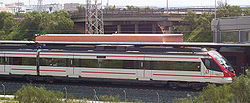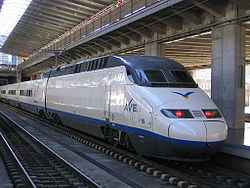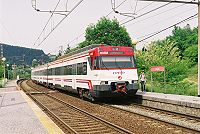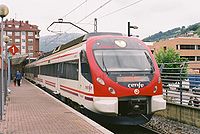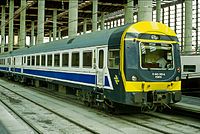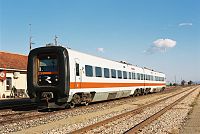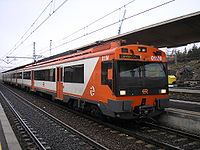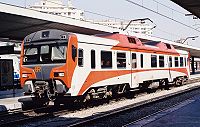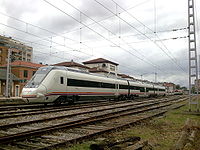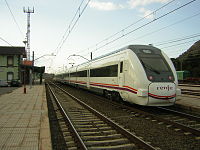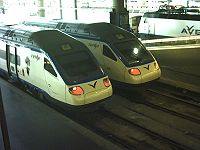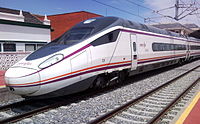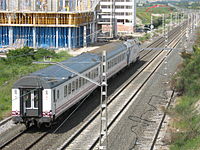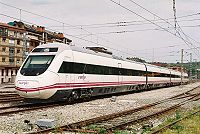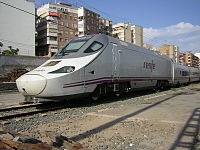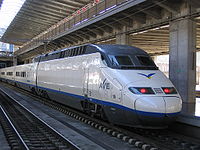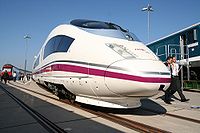- RENFE
-
Renfe operadora 
Type Incorporation Industry Rail transport Founded 2005 Headquarters Madrid, Spain Key people Teófilo Serrano Beltrán,
Enrique Urkijo Goitia,
Manuel Acero Valbuena,
José Luis MarroquínProducts Rail transport, Cargo Revenue  € 2.5 billion (2007)[1]
€ 2.5 billion (2007)[1]Operating income  € 240 million (2008) billion (2008) [1]
€ 240 million (2008) billion (2008) [1]Owner(s) Government of Spain (100%) Employees 14,338 (2007)[2] Subsidiaries Renfe Mercancías Website www.renfe.es RENFE 
Locale Spain Dates of operation January 24, 1941–2005 AVE Class 100 train at Cordoba station
Renfe Operadora is the state-owned company which operates freight and passenger trains on the 1668-mm "Iberian gauge" and 1435-mm "European gauge" networks of the Spanish national railway infrastructure company ADIF (Administrador de Infraestructuras Ferroviarias).
Contents
History
Further information: History of rail transport in SpainThe name RENFE is derived from that of the former Spanish National Railway Network, RENFE (Red Nacional de los Ferrocarriles Españoles) created on 24 January 1941 with the nationalization of Spain's railways. As per EU Directive 91/440, RENFE was divided into Renfe Operadora (operations) and ADIF (infrastructure) on 1 January 2005. At the same time, the existing RENFE double-arrowed logo (nicknamed the "galleta", Spanish for biscuit), first introduced in 1971 and facelifted in 1983, with a sans-serif font and again in 2000, with a mixed case italic font, has been replaced by a dark purple lower-case wordmark designed by Interbrand, and also replaces some of the separate logos used by the other sectors, although the old RENFE logo remains in use in some stations in Spain and on maps to indicate a RENFE station.
The Railway Sector Act of 2003 separated the management, maintenance and construction of rail infrastructure from train operation. The first activity is now the responsibility of a new public company, Administrador de Infrestructuras Ferroviarias (ADIF), while RENFE (full name: Renfe Operadora) owns the rolling-stock and remains responsible for the planning, marketing and operation of passenger and freight services (though no longer with a legal monopoly).
Renfe Operadora inherited the management model of the business units of the old RENFE, which made Renfe Operadora responsible for the operation of the following passenger and freight services. In January 2006, Renfe Operadora restructured the main business units into four:
- Dirección General de Servicios Públicos de Cercanías y Media Distancia: responsible for commuter services (Cercanías), medium-distance high-speed rail AVE services and medium-range regional services (Regionales and Media Distancia). However, control of some Cercanías services are transferred to Spain's Autonomous communities.
- Dirección General de Servicios de Larga Distancia: responsible for long-distance intercity and high-speed rail services (except medium-distance AVE services and Media Distancia, which is managed by the above business unit).
- Dirección General de Servicios de Mercancías y Logística: responsible for freight services.
- Dirección General de Fabricación y Mantenimiento: responsible for rolling stock maintenance and manufacture (also known as Integria)
The Spanish State railways are currently engaged in a major transformation and modernisation process to keep up with the liberalisation of railway transportation elsewhere in Europe. Key to this effort is a major overhaul of their dated ICT (information and communication technology) systems through an ICT renewal project scheduled for completion at the end of 2010 under the responsibility of Corporate Director of Information Systems Oscar Gomez Barbero. So far, the company has introduced improvements to their internet ticket sales and adopted new ICT management practices within a "more industrial" organisational model, though Mr Gomez has publicly acknowledged the difficulties in transforming what still remains a very hierarchical organisation.
Operations
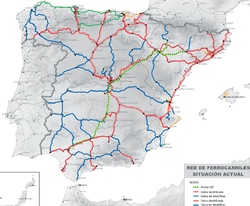 Map of the Spanish rail network as it was in 2005, with colour-coded track types. Renfe Operadora operates in broad and standard gauge lines.
Map of the Spanish rail network as it was in 2005, with colour-coded track types. Renfe Operadora operates in broad and standard gauge lines.
The company operates some 15,000 km of railways, 7,000 km of them electrified. Most of which are constructed to the broad "Iberian" gauge of 1668 mm, the same as that used in Portugal but wider than the gauge of 1435 mm which is standard in France and most of western and central Europe. The newer high-speed (AVE) network, however, has been built to the international standard gauge of 1435 mm in anticipation of its eventual connection to the rest of the European railway system. For this reason, the 1435-mm gauge is generally termed "European gauge" in Spain.
The Spanish high-speed system is called AVE. (Alta Velocidad Española, Spanish High Speed). The logo incorporates a feature which resembles a bird (ave in Spanish). The high-speed lines are built to the standard European gauge (1435 mm).
Construction of the high-speed rail line between Madrid and Seville began in 1988 and operation commenced in 1991. Train speed on the Seville line is 300 km/h. The second high-speed rail line (Madrid to Barcelona) was completed in 2007 with the inaugural service commencing at 6 am February 20, 2008. The operational speed on this route is 350 km/h. The greater part of the line (Madrid to Lleida) was placed into service on 11 October 2003, with connection to Huesca from Zaragoza. The third high-speed line (Madrid to Toledo) was opened in November 2005, followed by the spur from Córdoba to Málaga as far as Antequera in 2007. Another high-speed route from Madrid to Valladolid was opened in 2007, and other lines to Valencia and Lisbon are being designed. The route Madrid-Galicia is under construction between the major Galician cities.
Other lines operated by RENFE include Alaris, a moderate-speed line between Madrid and Valencia.
In addition to intercity transport, RENFE operates commuter train systems, known as Cercanías (or Rodalies in Catalonia and Cercanías-Aldirikoak in the Basque Country), in eleven metropolitan areas, including Madrid and Barcelona. The former was targeted in the 11 March 2004, Madrid train bombings. While the latter and some of the regional trains going to Barcelona have been without service since 20 October 2007. In some cities, RENFE shares the market with other commuter railway operators, such as FGC in Barcelona.
Passenger rolling stock
Renfe Operadora utilises the following rolling stock and commercial products inside of its two divisions:
D.G.S.P. Cercanías y Media Distancia
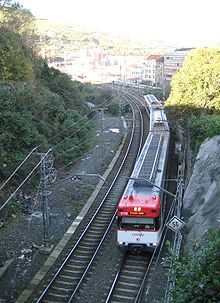 Renfe 446 EMU in Bilbao.
Renfe 446 EMU in Bilbao.
Cercanías:
Rolling stock City Image RENFE Class 442 Madrid LINEA C-9 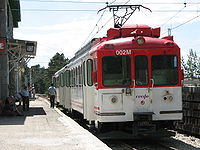
RENFE Class 446 Bilbao
Madrid
Málaga
San Sebastián
SantanderRENFE Class 447 Barcelona
Madrid
Valencia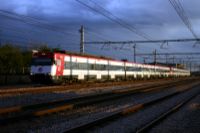
RENFE Class 450/451 Barcelona
Madrid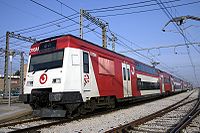
Civia Asturias
Barcelona
Cádiz
Madrid
Málaga
Santander
Sevilla
Valencia
ZaragozaRENFE Class 592 Valencia
Murcia Alicante
Media Distancia:
D.G.S.P. Larga Distancia
Grandes Líneas services and Largo recorrido Service Rolling stock Route(s) Image Conventional RENFE traditional services, with conventional rolling stock Diurno Locomotive + Passenger cars Basque Country <> Galicia / Salamanca Estrella Locomotive + sleeper cars Atlántico
Costa Brava
Galicia
Pío Baroja
Picasso
Sudexpress/SurexWith the disappearance of steam and the generalization of electric trains and diesel, some have improved their rolling stock whilst others retain the original rolling stock for the service. Alaris RENFE Class 490 Madrid <> Valencia
Madrid <> Castellón
Madrid <> Gandía
Madrid <> Oropesa de Mar
Barcelona <> Valencia
Barcelona <> Alicante
Altaria Locomotive + Talgo cars IV/VI/VII Madrid <> Algeciras
Madrid <> Granada
Madrid <> Cartagena
Madrid <> Murcia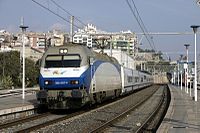
Alvia RENFE Class 120 Madrid <> Pamplona
Madrid <> Logroño
Madrid <> Hendaya
Madrid <> Irún
Barcelona <> VigoRENFE Class 130 Madrid <> Gijon
Madrid <> Santander
Madrid <> Bilbao
Madrid <> Hendaya
Alicante <> Gijon
Alicante <> SantanderMadrid <> Alicante
Madrid <> Cádiz
Madrid <> Huelva
Madrid <> LeonRENFE Class 730 Madrid <> Galicia (2012)
Madrid <> Cartagena (2012)
Madrid <> Murcia (2012)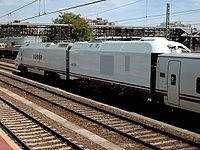
Arco Locomotive + conventional passenger cars refitted for 200 km/h operation García Lorca Barcelona <> Extremadura/Andalucía 
AVE RENFE Class 100 Madrid-Puerta de Atocha <> Sevilla-Santa Justa RENFE Class 102 Madrid-Puerta de Atocha <> Huesca
Madrid-Puerta de Atocha <> Zaragoza-Delicias]
Estación de Madrid-Chamartín <> Valladolid-Campo Grande
Madrid-Puerta de Atocha <> Málaga-Mª Zambrano
RENFE Class 103 Madrid-Puerta de Atocha <> Barcelona-Sants
Barcelona-Sants <> Málaga-Mª Zambrano
Barcelona-Sants <> Zaragoza-Delicias
Barcelona-Sants <> Sevilla-Santa JustaRENFE Class 112 Madrid-Puerta de Atocha <> Cuenca <> Valencia
Madrid-Puerta de Atocha <> Cuenca <> Albacete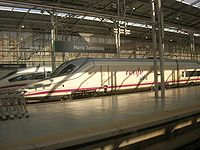
Euromed RENFE Class 130 Barcelona <> Valencia <> Alicante 
Intercity RENFE Class 448 Madrid-Chamartín <> Hendaya 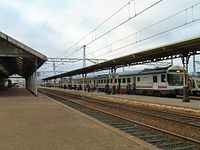
Talgo Locomotive + Talgo cars IV/VI/VII Catalán Talgo Barcelona <> Montpellier
Covadonga/Finisterre Barcelona <> Galicia/Gijón
Mare Nostrum Cartagena <> Montpellier
Miguel de Unamuno Barcelona <> País Vasco/Salamanca
Barcelona <> Lorca
Barcelona <> Murcia
Madrid <> Galicia
Alicante <> Galicia
Madrid <> Almería
Madrid <> Badajoz
Madrid <> Bilbao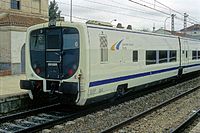
Trenhotel Locomotive + Talgo cars and sleeper cars Antonio Machado
Francisco de Goya
Gibralfaro
Joan Miró
Pau Casals
Rías Gallegas
Salvador Dalí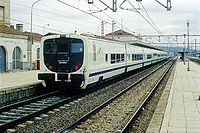
See also
- FEVE
- History of rail transport in Spain
- Rail transport in Spain
- Transportation in Spain
References
- ^ a b Cinco Días. "El 41,3% de los ingresos de Renfe proceden ya del AVE". http://www.cincodias.com/articulo/empresas/413-ingresos-Renfe-proceden-AVE/20090725cdscdiemp_3/. Retrieved 2010-12-28.
- ^ Renfe. "El equipo humano, principal activo de Renfe" (PDF). http://www.pactomundial.org/informeprogreso/recursos/doc/881/2008/1821_291229122008155055.pdf. Retrieved 2010-12-28.
- RENFE Corporate Director of Information Systems Oscar Gomez Barbero speaks of Renfe´s Transformation at ESADE Business School in Madrid.
- Fcmaf.castillalamancha.es
External links
Rail transport in Spain Operators AVE · RENFE · FEVE · EuskoTren · Ferrocarril de Sóller · Serveis Ferroviaris de Mallorca · Ferrocarrils de la Generalitat Valenciana · Ferrocarrils de la Generalitat de Catalunya · Acciona · COMSA Rail TransportCommuter lines Metro/Light rail Alicante · Barcelona Metro · Barcelona Tram · Bilbao Metro · Bilbao Tram · Madrid · Valencia · Málaga · Granada · Jaén · Vitoria-Gasteiz · Palma de Mallorca · Seville · Tenerife · Parla · Vélez-Málaga · Zaragoza TramNational railway companies of Europe  HSH •
HSH •  HYU1 •
HYU1 •  ÖBB •
ÖBB •  ADY1 •
ADY1 •  BŽD/BČ •
BŽD/BČ •  SNCB/NMBS •
SNCB/NMBS •  ŽFBH2 and ŽRS3 •
ŽFBH2 and ŽRS3 •  BDŽ •
BDŽ •  HŽ •
HŽ •  ČD •
ČD •  DSB •
DSB •
 EVR •
EVR •  VR •
VR •  SNCF •
SNCF •  SR1 •
SR1 •  DB •
DB •  TrainOSE •
TrainOSE •  MÁV •
MÁV •  IÉ •
IÉ •  FS •
FS •  KTŽ1 •
KTŽ1 •  HK/KŽ4 •
HK/KŽ4 •  LDZ •
LDZ •  LG •
LG •
 CFL •
CFL •  MŽ •
MŽ •  CFM •
CFM •  ŽCG •
ŽCG •  NS •
NS •  NSB •
NSB •  PKP •
PKP •  CP •
CP •  CFR •
CFR •  RŽD •
RŽD •  ŽS •
ŽS •  ŽSR •
ŽSR •  SŽ •
SŽ •
 RENFE •
RENFE •  SJAB •
SJAB •  SBB/CFF/FFS •
SBB/CFF/FFS •  TCDD1 •
TCDD1 •  UZ •
UZ •  BR5 / NR6 / NIR71Country partly in Asia • 2For the Federation BH • 3For Srpska • 4State with limited recognition • 51948-2000
BR5 / NR6 / NIR71Country partly in Asia • 2For the Federation BH • 3For Srpska • 4State with limited recognition • 51948-2000
6Created in 1999, owned by ATOC • 7For Northern IrelandCategories:- Railway companies of Spain
- Companies based in the Community of Madrid
- RENFE
- Government-owned companies in Spain
- Iberian gauge railways
- 2005 establishments in Spain
Wikimedia Foundation. 2010.

